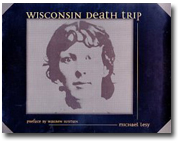Books |
Wisconsin Death Trip
Michael Lesy
By
Published: Sep 13, 2021
Category:
Non Fiction
There is an idea in media that we used to be better than this. “We,” of course, means white people, and in these dreamy takes, we got along. Yes, if you had money and good health and luck. But in rural America, by the testimony of this book, there were no “good old days.” This book is not pleasant. Eye-openers rarely are.
I came across this weird, disturbing and totally compelling book in the early 1970s, when some of the brighter minds of my generation were still considering “back to the land” options to big city careers. Remember Dylan’s “Nashville Skyline” CD? His rural man is a heroic figure: “His clothes are dirty, but his hands are clean.” And his priorities! He’s got a “big brass bed,” he’s “just watching the river flow.”
This image of “the country” is a brilliant sequel to the Norman Rockwell images that were imprinted on earlier generations — small towns, soda shops, girls with freckles, friendly doctors, little boys ripping off their clothes as they run to the swimming hole, Dad fishing in the rain, Mom having a gossip. In this world, you know your neighbors, you look out for one another, there’s no reason ever to forsake this small-town heaven. Those, those were the good old days.
The thing is, there were no good old days — they sucked. Thus…. ”Wisconsin Death Trip.”
Around 1970, Michael Lesy — a graduate student seeking the intersection of history and photography — chanced upon 3,000 glass negatives from one Wisconsin county between 1890 and 1910, years of great agitation in the heartland, economic upheaval and a vast migration from farms and small towns to the big city. Lesy’s revelation: "I’d stumbled into a holocaust without Jews, buried in the history of the heartland of the United States, at the end of an era that everyone kept calling the Gay Nineties."
“Wisconsin Death Trip” — a collection of photographs and newspaper snippets — takes you beyond socio-political truths to individual lives. And when you get down to individuals, “death trip” seems like just the right phrase:
The 60 year old wife of a farmer in Jackson, Washington County, “killed herself by cutting her throat with a sheep shears.”
“Mrs. James Baty… died suddenly of a hemorrhage of the lungs. She leaves a husband, her family of 6 children having died of diptheria last summer.”
“Mrs. John Larson… drowned her 3 children in Lake St. Croix during a fit of insanity… Mrs. Larson imagines that devils pursue her.”
“Mrs. Carter… was taken sick at the marsh last week and fell down, sustaining internal injuries which have dethroned her reason. She has been removed to her home here and a few nights since arose from her bed and ran through the woods… A night or two after she was found trying to strangle herself with a towel… It is hoped the trouble is only temporary and that she may soon recover her mind.”
The book begins with a photo of a white stallion. For reasons unknown, his mane has been allowed to grow almost to the ground. It’s a feminized image — until you notice the vastness of the horse’s penis. You’ve been warned: Weirdness follows. [To buy the paperback from Amazon, click here. Want a hardcover? Expensive.]
A paragraph catches my eye, about the naked, frozen body of a woman. She’d been separated from her husband; she’d had a child die. No one had noticed that she was suffering, but…. And here’s one about a workman who killed himself, leaving a wife and four kids “in destitute circumstances.”
Oh, the ways there are to kill yourself. Can you imagine hammering your own head? Or drowning yourself in the pool where your daughter had accidentally drowned?
The pictures tell equally horrible stories. Two coffins, leaned against the wall, with little children inside, flowers around their heads. Women, some obviously demented, others just grim. Men, in their Sunday best or at work, the youth draining out of them. Houses, streets, barns. A rare celebration. A fleeting moment of beauty in a rowboat.
Lesy’s intent in creating this pastiche of text and pictures, he said, was to present “a kind of soup bowl in which information would be mixed inside the brain of the viewer, and it would all be combined and sucked on and enjoyed. But it didn’t work that way. People remembered the horror stories. And only remembered the horror stories in their reading.”
Well, can you blame us? We like our reality prettified. But some reality just won’t submit. As Lesy writes, “By the end of the nineteenth century, country towns had become charnel houses and the counties that surrounded them had become places of dry bones.”
Interesting. But then, everything about this book is compelling — at the very least, it’s the most unusual book I can imagine having on a coffee table. Just be prepared: people will want to borrow it.


